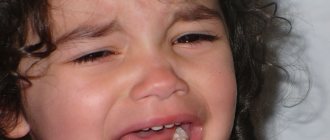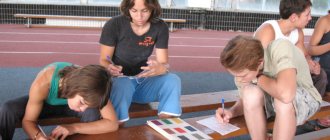Article:
Dyspraxia is a disorder of motor function and coordination of movements in a child with normal muscle tone.
The deviation is associated with a violation of tactile sensations and movement planning. Often the pathology manifests itself from birth, although parents do not immediately notice it. The fact that a child has problems with articulatory motor skills is most often reported by a speech therapist after examining the child. Experts first became aware of dyspraxia at the beginning of the last century. Initially it was called “clumsy child syndrome”, “sensory integration”, “developmental coordination disorder”, “developmental dyspraxia”. It is important not to confuse it with the term apraxia.
Main manifestations
Various degrees of dyspraxia are diagnosed in 3–6% of children, more often in boys. Many children are clumsy in early childhood, but a child with dyspraxia retains clumsiness even as an adult. Children who have been diagnosed with this disease find it difficult to perform everyday activities: they have difficulty speaking, often fall and stumble when walking, they have difficulty catching a ball in a game, maintaining balance when riding a bicycle, writing or reading something, etc. d.
Activities in which a child with dyspraxia has problems:
- speech – the work of the muscles of the articulatory apparatus is not coordinated, speech breathing is impaired;
- writing, drawing – difficulty holding a pen, brush, pencil, slow writing, long mastery of simple movements;
- reading - it is difficult to control eye movements and hold your gaze, which makes it difficult to follow the line with your eyes;
- performing basic movements when running, walking, jumping, maintaining balance;
- it is difficult to remember and reproduce the sequence of movements;
- games of high and medium mobility - children cannot catch and throw a ball, hold the attributes for the game, or use them.
Although modern medicine, and neuropathology in particular, is constantly developing innovative methods for preventing, treating and preventing disorders, dyspraxia in children is still an insufficiently studied problem.
What is the disease
Clumsiness, chaotic movements, lethargy, low motor skills.
All this can be said about people suffering from this disease. “Dyspraxia” is translated from Latin as “child clumsiness syndrome.” Only it is typical not only for children, but also for adults. The disease is quite serious and is defined in neurology as a violation of motor and speech functions. Patients constantly experience feelings of anxiety due to the inability to fully communicate with peers and adults, problems with the musculoskeletal system.
People susceptible to this disease honor themselves rather stupidly in the everyday world. Some patients are diagnosed with dyspraxia already at a conscious age, 20-25 years.
Dyspraxia in adults
It's more of an articulatory dyspraxia.
This disorder accompanies a person throughout his life. The diagnosis is made accurately, but scientists have not yet fully figured out its origin. It is only known that with this disease there is damage to certain areas of the brain. It has now been established reliably: children do not outgrow dyspraxia. If you do not take care of the child, the disease will worsen and go to a more serious stage.
In adults, motor dyspraxia more often persists, when there are obvious problems with handwriting, the inability to plan your day, and a lack of desire to get up early and not be late for work.
Household chores, such as regular cooking and cleaning, always cause rejection and discomfort in people with this diagnosis. The speed and accuracy of movements, coordination are impaired. People with this diagnosis are strictly prohibited from driving a car.
Adults diagnosed with dyspraxia are subject to frequent stress. There are situations when in childhood a person did not suffer from this disease, but in adulthood he cannot control his reflexes and doctors are forced to diagnose dyspraxia. This mystery is not yet clear to the scientific world.
Dyspraxia in adolescents and schoolchildren
Lazy and clumsy children are objects of increased attention from neurologists and pediatricians.
If the child’s movements are clumsy and he cannot control himself, the doctor has the right to doubt the baby’s normal condition and conduct additional examinations. The main ones are carried out by a neurologist. He studies the baby’s motor function, his reflexes and simple reactions. If the symptoms are confirmed, a diagnosis of dyspraxia is made. The motor skills of such children are significantly impaired. Their behavior is very different from the reactions of their peers. The intellect is preserved, but some tasks cause difficulties.
A child or teenager with dyspraxia gets along very quickly with their peers, but needs help when it comes to using fine motor skills. For example, tie your shoelaces or write a basic combination of words. Such children cannot ride a bicycle at any age.
According to statistics, about 6% of all newborns and 5-6% of the adult population suffer from motor coordination disorder. Such a child appears in every class. Most of these children also have concomitant illnesses, for example, dyslexia - a speech disorder. Such patients have a lower level of social skills. This means that they have a very difficult time going through the stages of socialization.
Causes and symptoms of childhood dyspraxia
This disease can be either primary or secondary. In the first case, the causes of dyspraxia are not associated with neuropathological disorders, however, they are not easy to determine without the use of special techniques. In the second case, dyspraxia is a consequence of traumatic brain injury, cerebral palsy, other pathologies of the nervous system, or is part of the symptoms of Down syndrome, autism, and Williams syndrome.
Presumable causes of the pathology:
- Genetic predisposition - mutations of the FOXP2 gene.
- Family inheritance in a direct line, from parents.
- Pathological course of pregnancy - stressful situations, toxic effects of drugs, waste products of bacteria during viral infections, the environment, oxygen starvation of the fetus.
- Post-term or premature pregnancy.
The basis of the pathology, according to medical research, is not damage, but underdevelopment of connections between neurons. As a result, the nerve impulse arising in the cerebral cortex does not find its way to the motor system.
Symptoms of pathology may vary depending on the age of the child. In the first year of life, dyspraxia manifests itself in the form of disturbances in congenital reflexes:
- disturbances of the sucking reflex;
- problems with fixation of gaze;
- difficulty grasping objects with the palm of your hand;
- impaired coordination of movements.
In preschool age, there is increased motor activity, poor attention, difficulties with eating and maintaining balance.
Symptoms of the disorder are as follows:
- delayed development of the ability to eat and dress;
- awkwardness in movements;
- difficulty identifying the dominant hand;
- frequent falls and stumbles while walking;
- inability to catch and throw a ball, jump, stand on one leg, ride a bicycle;
- difficulties with learning to read and write;
- difficulty walking in a straight line;
- difficulty finding an answer to a simple question, although the child knows it;
- problems with long-term memory, when the child forgets the educational material studied the day before;
- inability to remember and follow complex instructions;
- difficulty determining the right and left sides;
- sleep disorders;
- sensitivity to touch.
Sometimes the pathology manifests itself only in high school age. Usually, this requires a strong emotional stimulus - excessive study load, negative attitude of peers or teachers.
In school-age children, pathology most often manifests itself in the inability to master the material. Dictations and copying are especially difficult. Children suffer from dysgraphia and dyscalculia.
All these symptoms leave an imprint on the psycho-emotional state of the child. He is unable to realize his potential because he is constantly the target of ridicule from his peers. Children become anxious, irritable, and passive. They move away from their peers and are often left alone.
Articulatory dyspraxia
Verbal (or articulatory) dyspraxia is a speech disorder, namely a violation of the pronunciation aspect of speech, which is associated with underdevelopment or incorrect formation of articulatory praxis. With such dyspraxia, the mobility and tone of the muscles and their contractile abilities are preserved.
Typically, this pathology is included by outdated sources in the range of speech therapy disorders - dysarthria.
The main differences between articulatory dyspraxia and dysarthria:
- if a word is familiar or automated, then it is likely to be pronounced correctly; but the same sounds in other words may be pronounced incorrectly (that is, the problem is not in the pronunciation of the sound as such, but in the formation of the pronunciation skill);
- the child independently searches for an articulatory position;
- the number of errors largely depends on the surrounding situation and the emotional state of the child (when repeating after a familiar adult in a calm state, the pronunciation will be correct; in a frightened or nervous state, errors are likely).
The main difficulties in verbal dyspraxia: distortion of sounds (their omission or replacement with others, rearrangement of syllables, etc.) and difficulties in constructing sentences.
Self-diagnosis methods
It is very important to promptly draw the attention of specialists to this problem, because in preschool age the development of movements and the development of the psyche are closely related to each other. A lag in any area entails a distorted development of other personality traits. It is important to arrive at the threshold of schooling with maximum compensation for dyspraxia.
There is a simple way to initially diagnose dyspraxia that can be done at home - the jump test. You need to jump on two legs, accompanied by the count “one-two-three-four”, changing the movements of the legs in a certain sequence:
- one - legs to the sides;
- two – legs crossed (left leg in front of right);
- three – legs to the sides;
- four - legs crossed (right leg in front of left).
Signs of trouble:
- the child cannot jump according to the pattern suggested by the adult;
- he is unable to maintain the rhythm set by the score;
- crossing his legs, he turns his pelvis.
This diagnostic method is quite accurate and can be used from 4–5 years of age.
Professional help
If you suspect dyspraxia, you need to conduct an examination to clarify the diagnosis and find out the reasons for its development. The help of professionals will depend on the functions of the child most affected by the disease.
Thinking
If mental activity is impaired, a child psychologist will provide assistance. It will help the child systematize and organize his thinking. Thanks to the help of this specialist, the child will gain self-respect and confidence.
Speech
If you have a speech disorder, you will need the help of a speech therapist who will prevent deterioration and delay in speech.
Movements
Specialists help the child develop various complex movements, breaking them down into separate mini-movements and combining them later.
Treatment methods
To correct dyspraxia, modern innovative techniques using kinesiotherapy are used:
- stabilometry method with bioactive connection;
- dynamic correction with reflex-loading devices “Gravistat”, “Adelie”, “Graviton”;
- passive vestibular training using a computer stand;
- electrical stimulation of muscles;
- computer video analysis of movements;
- transcranial polarization of the brain.
Simultaneously with similar methods, pharmacological therapy with cerebroprotectors of nootropic action is used: Cytoflavin, Actovegin, Cortexin, Lecithin, Glycine, Semax, Gliatilin.
General therapeutic measures are highly effective - physical therapy, psychological and speech therapy correction. Much attention is paid to restoring the function of balance and basic movements, for which mobile and finger games and elements of sports games are used.
When treating verbal dyspraxia, the speech therapist chooses a special system of exercises for the child, one part of which is aimed at developing the pronunciation of sounds, and the second at restoring articulation.
- The first option involves teaching the child accurate articulation of phonemes. Much attention is paid to sound patterns.
- The essence of the second option is to actively train the facial muscles responsible for articulation. At the beginning of therapy, the baby imitates the elementary movements of the lips and tongue, the description of which is wrapped in a fairy tale plot (“The Tale of the Merry Tongue”). Upon completion of the correction, he must independently reproduce a sequence of several movements.
Children with dyspraxia are encouraged to participate in group gymnastics classes. They perfectly develop the vestibular apparatus, and the child gains control over his movements. Games with musical accompaniment are very useful. While playing them, children will feel the rhythm, which allows them to improve body control and coordination.
Causes
Correction of dyspraxia is the constant work of parents and specialists.
Kinetic dyspraxia
, a motor and articulatory type of illness, has a number of non-standard causes. Experts associate the manifestations of the disease with incomplete development of neurons, which occurs in the brain.
Most researchers tend to believe that the causes of dyspraxia lie in a genetic predisposition, when both parents are underdeveloped and suffer from a number of nervous system ailments.
Among the main components contributing to the development of dyspraxia:
- Microtraumas of the brain that occur during childbirth or in the first days after the birth of the baby.
- Genetic mutations.
- Prematurity.
It is almost impossible to help such patients on your own. This requires a concentration of forces from specialists at various levels.








